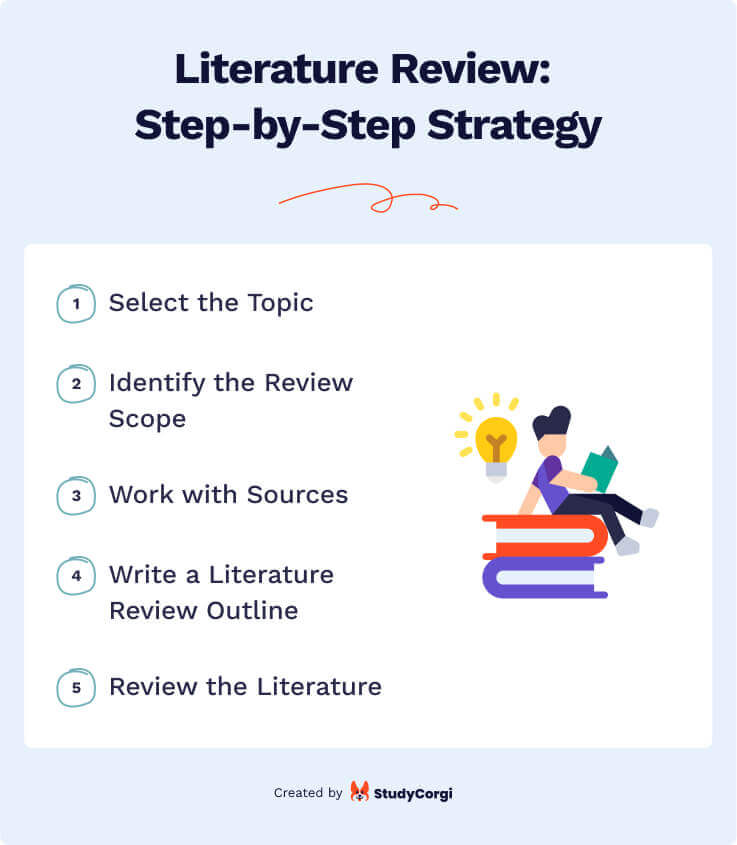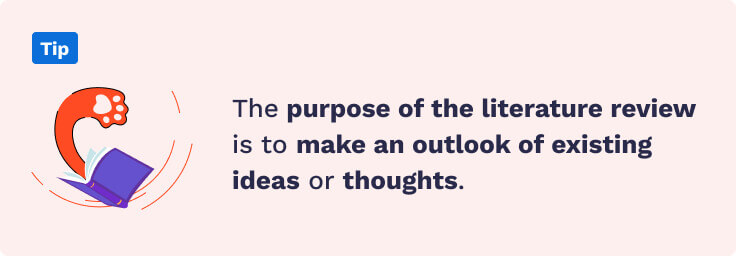Writing a literature review might be easier than you think. You should understand its basic rules, and that’s it! This article is just about that.
Why is the literature review important? What are its types? We will uncover these and other possible questions.
Whether you are an experienced researcher or a student, this article will come in handy. Keep reading!
What Is a Literature Review?
Let’s start with the literature review definition.
Literature review outlooks the existing sources on a given topic. Its primary goal is to provide an overall picture of the study object. It clears up the context and showcases the analysis of the paper’s theoretical methodology.
In case you want to see the examples of this type of work, check out our collection of free student essays.
Importance of Literature Review
In most cases, you need to write a literature review as a part of an academic project. Those can be dissertations, theses, or research papers.
Why is it important?
Imagine your final research as a 100% bar. Let’s recall Pareto law: 20% of efforts make 80% of the result. In our case, 20% is preparing a literature review. Writing itself is less important than an in-depth analysis of current literature. Do you want to avoid possible frustration in academic writing? Make a confident start with a literature review.
Sure, it’s impossible to find a topic that hasn’t been discussed or cited. That is why we cannot but use the works of other authors. You don’t have to agree with them. Discuss, criticize, analyze, and debate.
So, the purpose of the literature review is to give the knowledge foundation for the topic and establish its understanding. Abstracting from personal opinions and judgments is a crucial attribute.

Types of Literature Review
You can reach the purpose we have discussed above in several ways, which means there are several types of literature review.
What sets them apart?
In short, it’s their research methods and structure. Let’s break down each type:
- Systematic literature review is the most precise and well-defined type. It identifies, evaluates, and appraises the studied topic. The purpose is to get the lay of the land in a given research area.
It falls into meta-analysis and meta-synthesis. They differ in the undertaken approach: deductive or inductive.- Meta-analysis implies the deductive approach. At first, you gather several related research papers. Then, you carry out its statistical analysis. As a result, you answer a formulated question.
- Meta-synthesis goes along with the inductive approach. It bases qualitative data assessment.
- Theoretical literature review implies gathering theories. Those theories apply to studied ideas or concepts. Links between theories become more explicit and clear. Why is it useful? It confirms that the theoretical framework is valid. On top of that, it assists in new hypothesis-making.
- Argumentative literature review starts with a problem statement. Then, you select and study the topic-related literature to confirm or deny the stated question. There is one sufficient problem in this type, by the way. The author may write the text with a grain of bias.
- Narrative literature review focuses on literature mismatches. It indicates possible gaps and concludes the body of literature. The primary step here is stating a focused research question. Another name for this type — a traditional literature review.
- Integrative literature review drives scientific novelty. It generates new statements around the existing research. The primary tool for that is secondary data. The thing you need is to review and criticize it. When is the best option to write an integrative literature review? It’s when you lack primary data analysis.
Remember: before writing a literature review, specify its type. Another step you should take is to argue your choice. Make sure it fits the research framework. It will save your time as you won’t need to figure out fitting strategies and methods.
Annotated Bibliography vs. Literature Review
Some would ask: isn’t what you are writing about is just an annotated bibliography? Sure, both annotated bibliography and literature review list the research topic-related sources. But no more than that. Such contextual attributes as goal, structure, and components differ a lot.
For a more visual illustration of its difference, we made a table:
To sum up: an annotated bibliography is more referral. It does not require reading all the sources in the list. On the contrary, you won’t reach the literature review purpose without examining all the sources cited.

Literature Review: Step-by-Step Strategy
Now it’s time for a step-by-step guide. We are getting closer to a perfect literature review!
✔️ Step 1. Select the Topic
Selecting a topic requires looking from two perspectives. They are the following:
- Stand-alone paper. Choose an engaging topic and state a central problem. Then, investigate the trusted literature sources in scholarly databases.
- Part of a dissertation or thesis. In this case, you should dig around the thesis topic, research objectives, and purpose.
Regardless of the situation, you should not just list several literature items. On the contrary, build a decent logical connection and analysis. Only that way, you’ll answer the research question.
✔️ Step 2. Identify the Review Scope
One more essential thing to do is to define the research boundaries: don’t make them too broad or too narrow.
Push back on the chosen topic and define the number and level of comprehensiveness of your paper. Define the historical period as well. After that, select a pool of credible sources for further synthesis and analysis.
✔️ Step 3. Work with Sources
Investigate each chosen source. Note each important insight you come across. Learn how to cite a literature review to avoid plagiarism.
✔️ Step 4. Write a Literature Review Outline
No matter what the writing purpose is: research, informative, promotional, etc. The power of your future text is in the proper planning. If you start with a well-defined structure, there’s a much higher chance that you’ll reach exceptional results.
✔️ Step 5. Review the Literature
Once you’ve outlined your literature review, you’re ready for a writing part. While writing, try to be selective, thinking critically, and don’t forget to stay to the point. In the end, make a compelling literature review conclusion.
On top of the above five steps, explore some other working tips to make your literature review as informative as possible.

Literature Review Outline
We’ve already discussed the importance of a literature review outline. Now, it’s time to understand how to create it.
An outline for literature review has a bit different structure comparing with other types of paper works. It includes:
- Introduction. In this part, you should outline the following characteristics:
- Selected topic
- Research question
- Related research question trends and prospects
- Research methods
- Expected research results
- Body. Each paragraph should focus on one of the entries. The number of paragraphs is equivalent to the number of literature sources. What do you need to outline here? Write a summary of each selected resource. The following are examples of subjects to cover:
- Overview of literature core areas
- Research problem consideration through the prism of this piece of literature
- Methods, controversial points, gaps
- Outcomes
- Conclusion. Make clear points of inference and explain the relationships between the studied pieces of literature. A good conclusion should contain:
- Cumulative list of arguments around the research question
- Links to existing literature and a place of your paper in the existing system of knowledge.
It can be a plus if you clarify the applicability of your literature review in further research.
Once you outline your literature review, you can slightly shorten your writing path. Let’s move on to actual samples of literature review.
Literature Review Examples
How does a well-prepared literature review look like? Check these three StudyCorgi samples to understand. Follow the table:
Take your time and read literature review examples to solidify knowledge and sharpen your skills. You’ll get a more definite picture of the literature review length, methods, and topics.
Do you still have any questions? Don’t hesitate to contact us! Our writing experts are ready to help you with your paper on time.
✏️ FAQ
❓ What Is the Purpose of a Literature Review?
Literature review solves several problems at once. Its purpose is to identify and gather the top insights, gaps, and answers to research questions. Those help to get a general idea of the degree of topic exploration. As a result, it forms a basis for further research. Or vice versa: it reveals a lack of need for additional studies.
❓ How Do You Structure a Literature Review?
Like any other academic paper, a literature review consists of three parts: introduction, main body, and the conclusion. Each of them needs full disclosure and logical interconnection
The introduction contains the topic overview, its problematics, research methods, and other general attributes of academic papers.
The body reveals how each of the selected literature sources answers the formulated questions from the introduction.
The conclusion summarizes the key findings from the body, connects the research to existing studies, and outlines the need for further investigation.
To ensure the success of your analysis, you should equally uphold all of these parts.
❓ What Must a Literature Review Include?
A basic literature review includes the introduction with the research topic definition, its arguments, and problems. Then, it has a synthesis of the picked pieces of literature. It may describe the possible gaps and contradictions in existing research. The practical relevance and contribution to new studies are also welcome.
❓ What Are the 5 C’s of Writing a Literature Review?
Don’t forget about these five C’s to make things easier in writing a literature review:
Cite. Make a list of references for research you’ve used and apply proper citation rules. Use Google Scholar for this.
Compare. Make a comparison of such literature attributes as theories, insights, trends, arguments, etc. It’s better to use tables or diagrams to make your content visual.
Contrast. Use listings to categorize particular approaches, themes, and so on.
Critique. Critical thinking is a must in any scientific research. Don’t take individual formulations as truth. Explore controversial points of view.
Connect. Find a place of your research between existing studies. Propose new possible areas to dig further.
❓ How Long Should a Literature Review Be?
In most cases, professors or educational establishment guidelines determine the length of a literature review. Study them and stick to their requirements, so you don’t get it wrong.
If there are no specific rules, make sure it is no more than 30% of the whole research paper.
If your literature review is not a part of the thesis and goes as a stand-alone paper — be concise but explore the research area in-depth.
![Literature Review: Outline, Strategies, and Examples [2024]](https://studycorgi.com/wp-content/uploads/2021/10/book-bible-close-up-beautiful-terrace-morning-time-space-text-1143x528.jpg)